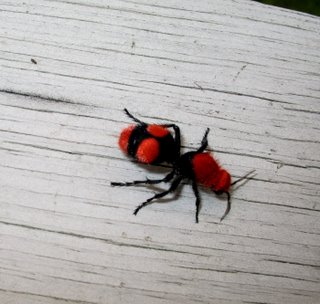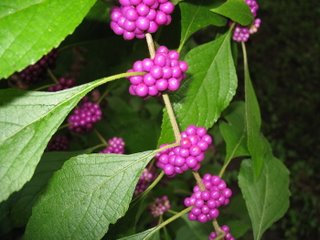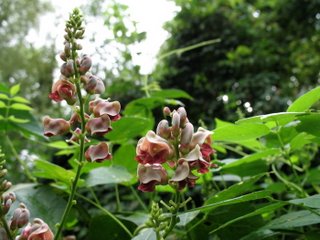The Cow Killer
A big spider seems to always get your attention. Even if you don’t care much if small ones run across your sandaled and sockless foot, big ones will usually cause an avoidance reaction by us humans. The lady in the picture is about four inches toe tip to tip. Most of us have a memory of walking through the woods (or just the yard) when we were young and suddenly having a big sticky web plastered across our face. You try to pull it off and it sticks to your hands, and your glasses, and your hair. If you happen to be interested in nature you will probably know what spider made that huge gluey web, and then you will worry less about getting the web off than finding the very large spider that made it. If you are alone, you cannot see if it is walking along your back near your shoulder blades, coming closer to your neck. And you wonder if it is irritated by your total destruction of its home and food-gathering device. Or maybe it is on top of your hat riding along contemplating its next move. You wonder where the middle of the web was because that may be where the spider was prior to impact. Is that the middle of the web on your chest
 ? And who told you that wearing loose clothing was a good idea?! If you feel it crawling along your stomach inside your shirt, do you dare hit it and thereby almost surely surpass whatever tolerance it has left for your violent activities? I wouldn’t hit it, but that shirt would come off the quickest possible way! But we may rest easy, this spider, the banana spider, does not seem to be aggressive, at least not the ones I know. Encounters like this, however, may explain why a lot of people do not like to be outdoors these days of video games and football games and Internet action. Those indoor things don’t jump on you. The big female banana spider in the picture (and her tiny male cohabiter) is resident in our yard. I run into them often on the lawn mower, but so far they don’t mind if I live here too, and next morning there is a new web for me to blunder into.
? And who told you that wearing loose clothing was a good idea?! If you feel it crawling along your stomach inside your shirt, do you dare hit it and thereby almost surely surpass whatever tolerance it has left for your violent activities? I wouldn’t hit it, but that shirt would come off the quickest possible way! But we may rest easy, this spider, the banana spider, does not seem to be aggressive, at least not the ones I know. Encounters like this, however, may explain why a lot of people do not like to be outdoors these days of video games and football games and Internet action. Those indoor things don’t jump on you. The big female banana spider in the picture (and her tiny male cohabiter) is resident in our yard. I run into them often on the lawn mower, but so far they don’t mind if I live here too, and next morning there is a new web for me to blunder into.
Then there is the cow killer. This is the name given by folks in the eastern U.S to the one-inch long velvet ant. For those who don’t know, this insect is actually a wingless species of wasp. We called them red ants when I was growing up, well before the invasion of fire ants – now sometimes called red ants by some people. But the cow killer is a fearsome animal best left alone. It has a very large sting, and a very, very painful venom. If you pin it down with a twig, it eeennnkks at you, loudly. It is not a good idea to try this. As a boy I would try to kill these wasps by stepping on them (with shoes on) and it was impossible to damage them if they were on a soft surface like the ground. If you had soft-soled shoes it was even hard to kill them on concrete. They are unbelievably tough. The one pictured here is r
 unning at a good clip along the hand rail of the walkway to the river. Normally, I would try to stop the action long enough to take a good picture, but not this time and not this animal. That’s why the picture is a little unfocused.
unning at a good clip along the hand rail of the walkway to the river. Normally, I would try to stop the action long enough to take a good picture, but not this time and not this animal. That’s why the picture is a little unfocused. Most southern gardners are familiar with the American beautyberry, or French mulberry. It is a native plant that has considerable wildlife value. Several kinds of birds combine to clean every fruit from our plants every year. The purple variety seems to be the more common one in local gardens, but thanks to Bill Fontenot, we have a white-fruited variety. The plant is not as vigorous as the purple one, but this year the rain seems to have encouraged a nice display of white fruit, worthy of a picture. I have had a lot of trouble taking good pictures of very white things. The desired image is usually indistinct and overexposed. Th
Most southern gardners are familiar with the American beautyberry, or French mulberry. It is a native plant that has considerable wildlife value. Several kinds of birds combine to clean every fruit from our plants every year. The purple variety seems to be the more common one in local gardens, but thanks to Bill Fontenot, we have a white-fruited variety. The plant is not as vigorous as the purple one, but this year the rain seems to have encouraged a nice display of white fruit, worthy of a picture. I have had a lot of trouble taking good pictures of very white things. The desired image is usually indistinct and overexposed. Th is time the pictures are worth sharing, I think.
is time the pictures are worth sharing, I think.A couple postings ago, I showed a picture of a silver-spotted skipper, today I found its other common cousin – the long tailed skipper. The iridescent blue on its back wasn’t seen until the images were put on the computer.
 Lastly, the pea-like flowers of this vine are pretty, but man is this plant a big problem. It is our version of kudzu. It covers everything. I heard some talk about it last summer but it wasn’t very noticeable here at that time. Well, now it is a pest, unless you like to think of your whole yard as being just a substrate for this vine to climb on. But admit it, the flowers are pretty.
Lastly, the pea-like flowers of this vine are pretty, but man is this plant a big problem. It is our version of kudzu. It covers everything. I heard some talk about it last summer but it wasn’t very noticeable here at that time. Well, now it is a pest, unless you like to think of your whole yard as being just a substrate for this vine to climb on. But admit it, the flowers are pretty.The river is at 1.8 feet on the Butte La Rose gauge, falling to 1.5 by Wednesday. That’s low, my friend. The Ohio and Mississippi are both falling all the way up. Looks like this week may be the week to go out and survey the sunken boats near Flat Lake.
Rise and Shine, Jim


2 Comments:
Love the pictures and info on the red ant. I see them from time to time...didn't know they would bite! White beautyberry is new to me and I agree the vine is pretty. Kinda like honeysuckle, a little goes a long way?
It is easy to think something as pretty as the velvet ant wouldn't be dangerous, but this one is, believe me. If you are ever down here we can see about getting you a start of the white beautyberry, if you want one. And yes, a little of that vine goes a very long way. Thanks for the comment Carolyn! Jim
Post a Comment
<< Home